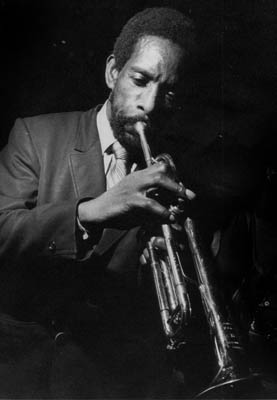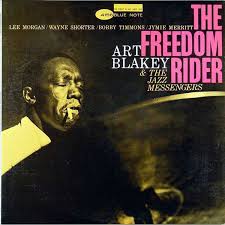Blue Ching – Kenny Dorham
K.D. wrote this stop-time blues head for Art Blakey and the Jazz Messengers, as a showcase for their trademark dynamic range. Second parts and rhythm section parts are available for this quintet arrangement.
- Recording: Art Blakey - Freedom Rider
- Recorded on: February 12, 1961
- Label: Blue Note (8-21287-2)
- Concert Key: B-flat
- Vocal Range: , to
- Style: Swing (medium)
- Trumpet - Lee Morgan
- Tenor Sax - Wayne Shorter
- Piano - Bobby Timmons
- Bass - Jymie Merritt
- Drums - Art Blakey
0:00
0:00
Buy MP3
Video
- Description
- Historical Notes
- Solos
- Piano Corner
- Bass Corner
- Drum Corner
- Guitar Corner
- Inside & Beyond
- Minus You
This blues head is an Art Blakey & The Jazz Messengers classic, with the stop-time and dynamic contrasts that that band thrived on. It's based on a call-and-response two-measure riff similar in overall structure to Moanin', though with the response chords held out behind the melody phrases. The melody is entirely pentatonic; the "response" chords are V-I cadences instead of the IV-I in Moanin'.
This song's dynamics are integral to the arrangement. The first chorus of the in head has the horns playing the melody, voiced in fourths, with rhythm section responses; it begins softly and builds all the way to the eighth measure. The second chorus uses piano for the melody (in octaves), with horns, bass, and drums responding; this chorus remains relatively soft (rhythm section mf, horns mp) with no crescendo. On this recording, the out head's arrangement is reversed: the first chorus has the piano melody, while the horns take over for the second chorus and coda. We have indicated this in the lead sheet with a double coda sign where the "first" chorus (the chorus with the horns playing the melody) would go to the coda. The single coda sign can also be used if you choose to play the out head the same way as the in head.
Our rhythm section parts (Piano, Bass & Condensed Score for the drummer) show as much as possible what is going on among the other instruments. We feel this is especially important in stop-time songs like this one.
This song's dynamics are integral to the arrangement. The first chorus of the in head has the horns playing the melody, voiced in fourths, with rhythm section responses; it begins softly and builds all the way to the eighth measure. The second chorus uses piano for the melody (in octaves), with horns, bass, and drums responding; this chorus remains relatively soft (rhythm section mf, horns mp) with no crescendo. On this recording, the out head's arrangement is reversed: the first chorus has the piano melody, while the horns take over for the second chorus and coda. We have indicated this in the lead sheet with a double coda sign where the "first" chorus (the chorus with the horns playing the melody) would go to the coda. The single coda sign can also be used if you choose to play the out head the same way as the in head.
Our rhythm section parts (Piano, Bass & Condensed Score for the drummer) show as much as possible what is going on among the other instruments. We feel this is especially important in stop-time songs like this one.
"The Freedom Rider" was recorded at the legendary Van Gelder Studio in Englewood Cliffs.
Blue Ching was originally released on an Art Blakey album called "Pisces," a Japanese release.
A month after this session, Kenny Dorham made his own recording of Blue Ching with Charles Davis on baritone sax, Grant Green on guitar, Kenny Drew on piano, bassist Wilbur Ware, and drummer Philly Joe Jones. That session, made for Blue Note, has never been released.
Blue Ching was originally released on an Art Blakey album called "Pisces," a Japanese release.
A month after this session, Kenny Dorham made his own recording of Blue Ching with Charles Davis on baritone sax, Grant Green on guitar, Kenny Drew on piano, bassist Wilbur Ware, and drummer Philly Joe Jones. That session, made for Blue Note, has never been released.
Related Songs
Email Send Blue Ching to a friend
Send this page to a friend via email. Add your name or email in the first field. In the second, add one or more email addresses, separated by a comma.

Kenny Dorham
August 30, 1924 – December 15, 1972
August 30, 2025, is Kenny Dorham's 101st birthday: jazzleadsheets.com has added many new K.D. compositions. Jazz At Lincoln Center has dedicated three late-night sets to Kenny's music, played with love by young musicians who want his music to live on. Join in, play K.D. music! Read more...
There was a problem.
...

